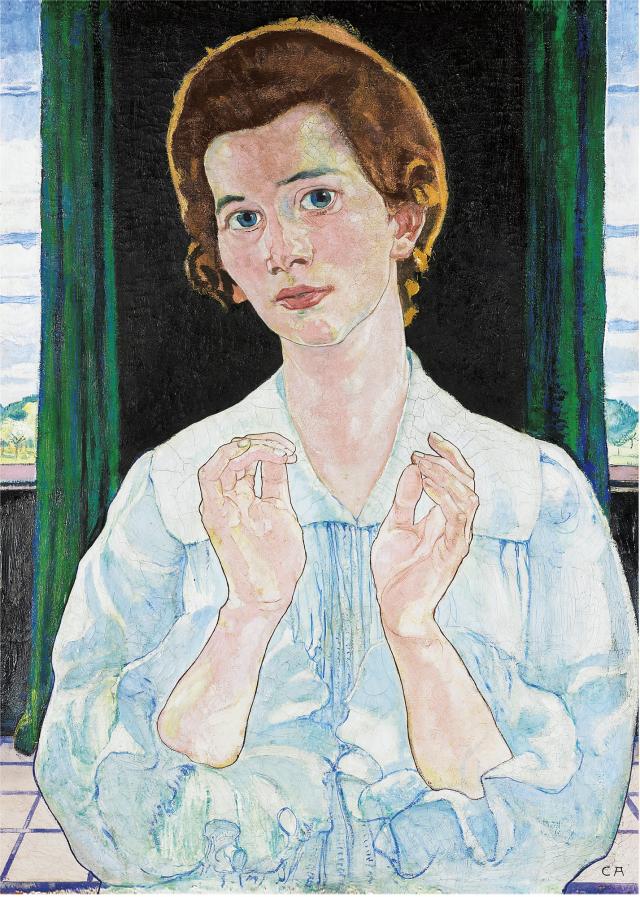In the whole of his pictorial output, Cuno Amiet rarely returns to the same composition to produce several variants. Richesse du soir (Evening Treasures, 1899), Rosenbäumchen (Little Rosebushes, 1902), Kinderakt (Infant Nude, 1903) and Die Hoffnung (Hope) are the exceptions, however. There are four versions of Die Hoffnung, including two that date from 1901 – the version in the Collection Pictet being the earlier one. This is the year the painter and his wife are expecting their first child.
Projecting the arrival of this future infant, Amiet paints his wife as if she were a Renaissance Virgin, before a wall hanging and a floor suggesting the mathematical perspectives of the period. Anna Amiet is shown raising her forearms in a symmetrical pose that shares in the painting’s studied layout. Her graceful, sensuous hands emerge from a decoratively shaped white blouse while her large gentle eyes lend her the look of a saint, symbolically expressed by an ochre circle drawn around the outline of her hair. Through the wonder-filled eyes of the future father, Die Hoffnung evokes all the tenderness that is characteristic of an Annunciation. Yet the outcome of this pregnancy will prove dramatic, ending in the birth of a stillborn infant.
In the face of this suffering, the artist completes a new version of the same picture. He adds two lateral panels and transforms the piece into a triptych he calls Die Vergänglichkeit (The Ephemeral, 1902). The two adjacent wings feature two skeletons, one male, the other female, which stand as metaphorical views of the father’s and mother’s pain before the loss of their child, both of whom are condemned to the vanity of their existence and denied a descendant of their own. This painting was exhibited at the 1904 Vienna Secession and would give rise to one last version the same year.
Projecting the arrival of this future infant, Amiet paints his wife as if she were a Renaissance Virgin, before a wall hanging and a floor suggesting the mathematical perspectives of the period. Anna Amiet is shown raising her forearms in a symmetrical pose that shares in the painting’s studied layout. Her graceful, sensuous hands emerge from a decoratively shaped white blouse while her large gentle eyes lend her the look of a saint, symbolically expressed by an ochre circle drawn around the outline of her hair. Through the wonder-filled eyes of the future father, Die Hoffnung evokes all the tenderness that is characteristic of an Annunciation. Yet the outcome of this pregnancy will prove dramatic, ending in the birth of a stillborn infant.
In the face of this suffering, the artist completes a new version of the same picture. He adds two lateral panels and transforms the piece into a triptych he calls Die Vergänglichkeit (The Ephemeral, 1902). The two adjacent wings feature two skeletons, one male, the other female, which stand as metaphorical views of the father’s and mother’s pain before the loss of their child, both of whom are condemned to the vanity of their existence and denied a descendant of their own. This painting was exhibited at the 1904 Vienna Secession and would give rise to one last version the same year.
